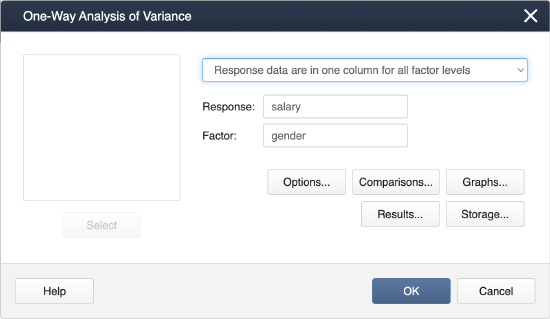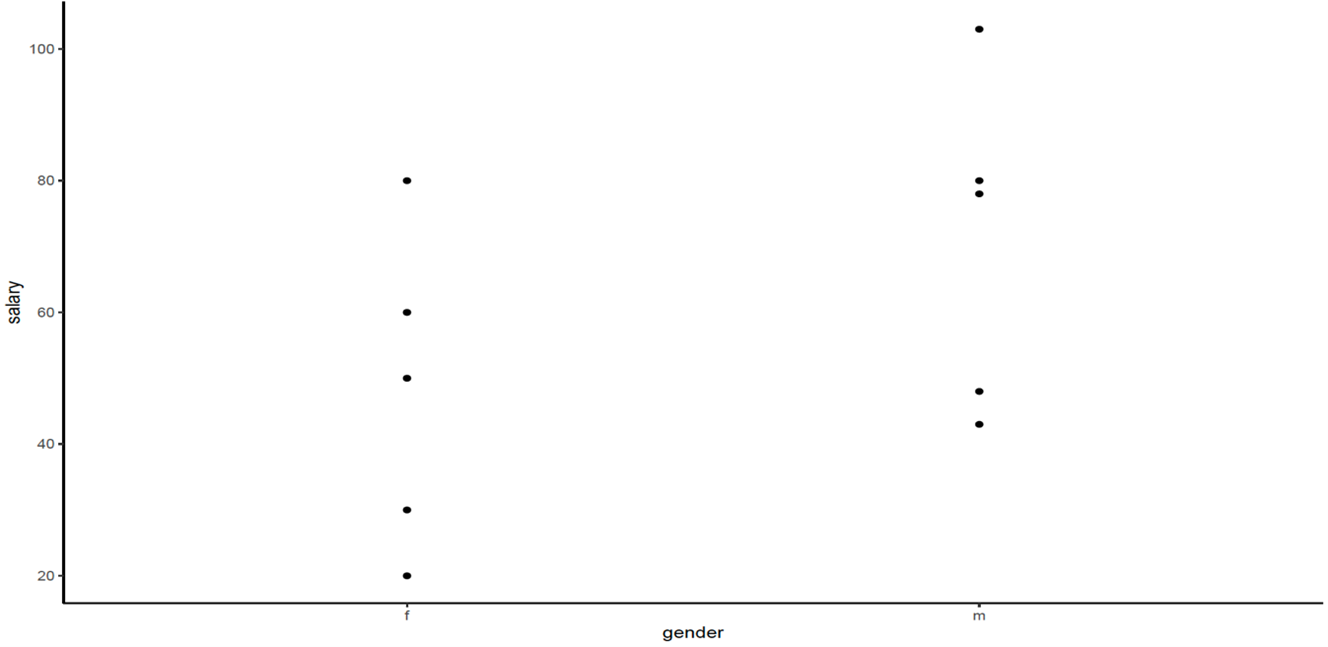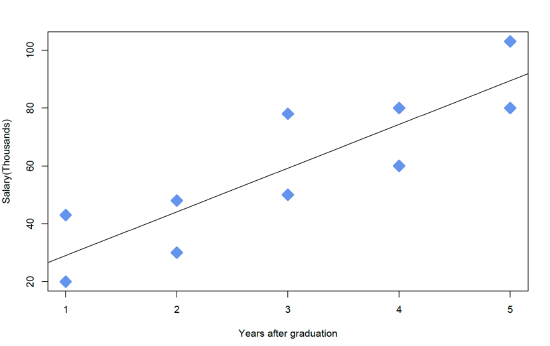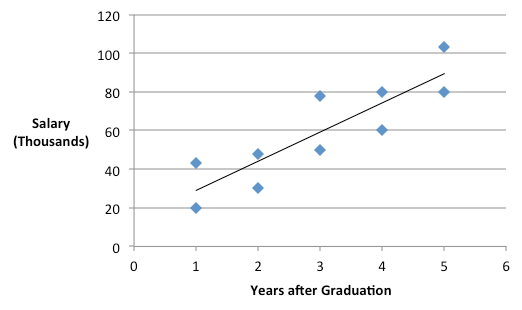9.1: Role of the Covariate
- Page ID
- 33166
To illustrate the role the covariate has in the ANCOVA, let’s look at a hypothetical situation wherein investigators are comparing the salaries of male vs. female college graduates. A random sample of 5 individuals for each gender is compiled, and a simple one-way ANOVA is performed:
| Males | Females |
|---|---|
| 78 | 80 |
| 43 | 50 |
| 103 | 30 |
| 48 | 20 |
| 80 | 60 |
\(H_{0}: \ \mu_{\text{males}} = \mu_{\text{females}}\)
- Using SAS
-
SAS coding for the One-way ANOVA:
data ancova_example; input gender $ salary; datalines; m 78 m 43 m 103 m 48 m 80 f 80 f 50 f 30 f 20 f 60 ; proc mixed data=ancova_example method=type3; class gender; model salary=gender; run;
Here is the output we get:
Type 3 Tests of Fixed Effects Effect Num DF Den DF F Value Pr > F gender 1 8 2.11 F">0.1840
- Using Minitab
-
To perform a one-way ANOVA test in Minitab, you can first open the data (ANCOVA Example Minitab Data) and then select Stat > ANOVA > One Way…
In the pop-up window that appears, select salary as the Response and gender as the Factor.

Figure \(\PageIndex{1}\): Minitab One-Way Analysis of Variance window Click OK, and the output is as follows.
Analysis of Variance
Source DF SS SS F-Value P-Value gender 1 1254 1254 2.11 0.184 Error 8 4745 593 Total 9 6000 Model Summary
S R-sq R-sq(adj) R-sq(pred) 24.3547 20.91% 11.02% 0.00%
- Using R
-
Tasks:
- Load the ANCOVA example data.
- Obtain the ANOVA table.
- Plot the data.
1. Load the ANCOVA example data and obtain the ANOVA table by using the following commands:
setwd("~/path-to-folder/") ancova_example_data <- read.table("ancova_example.txt",header=T) attach(ancova_example_data) ancova<-aov(salary ~ gender,ancova_example_data) summary(ancova) # Df Sum Sq Mean Sq F value Pr(>F) #gender 1 1254 1254.4 2.115 0.184 #Residuals 8 4745 593.12. Plot for the data, salary by gender, by using the following commands:
library(ggplot2) myplot<-ggplot(ancova_example_data, aes(x = gender, y = salary)) + geom_point() myplot + theme_bw() + theme(panel.border = element_blank(), panel.grid.major = element_blank(), panel.grid.minor = element_blank(), axis.line = element_line(colour = "black"))

Figure \(\PageIndex{2}\): Gender and salary plot 3. Plot for the data, salary vs years, by using the following commands:
plot(years,salary, xlab="Years after graduation", ylab="Salary(Thousands)",pch=23,cex=2, col="cornflowerblue", bg="cornflowerblue", lwd=2) abline(lm(salary~years,data=ancova_example_data)) detach(ancova_example_data)

Figure \(\PageIndex{3}\): Plot of salary vs years Because the \(p\)-value > \(\alpha\) (=0.05), they can't reject the \(H_{0}\).
A plot of the data shows the situation:
.png?revision=1&size=bestfit&width=476&height=365)
Figure \(\PageIndex{4}\): Plot of salary vs gender However, it is reasonable to assume that the length of time since graduation from college is also likely to influence one's income. So more appropriately, the duration since graduation, a continuous variable, should be also included in the analysis, and the required data is shown below.
Females Males Salary years Salary years 80 5 78 3 50 3 43 1 30 2 103 5 20 1 48 2 60 4 80 4 
Figure \(\PageIndex{5}\): Plot of salary vs years since graduation The plot above indicates an upward linear trend between salary and the number of years since graduation, which could be a marker for experience and/or postgraduate education. The fundamental idea of including a covariate is to take this trend into account and to "control" it effectively. In other words, including the covariate in the ANOVA will make the comparison between Males and Females after accounting for the covariate.


